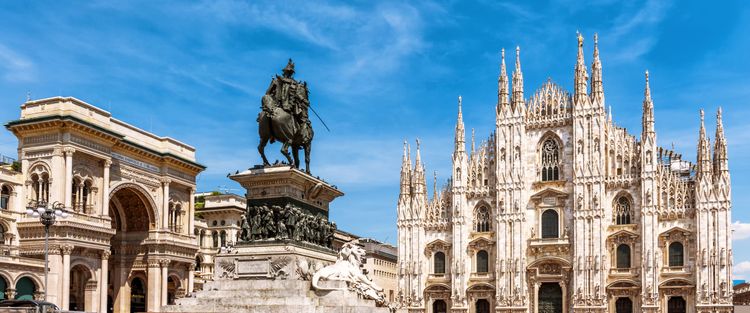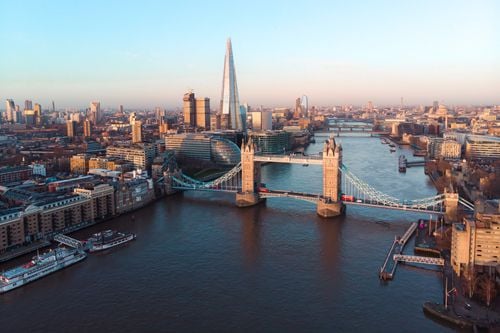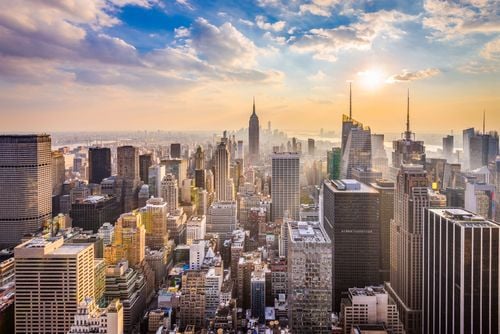Under the orders of the Duke of Milan, Francesco Sforza, Solari was commissioned to build a church and a Dominican convent on land already occupied by the chapel of Santa Maria delle Grazie, famous for its frescoes of the Virgin Mary. Built in the fifteenth century by the architect Guiniforte Solari, the architecture of the basilica of Santa Maria delle Grazie was magnified a few years later by Bramante, to give it the appearance we know today. It was he who designed the new apse, which reaches a height of 40 metres.
Milan has no shortage of religious buildings. The city boasts more than forty churches, each with its own special character. Among them, the Basilica of Santa Maria delle Grazie is one of the must-see sights in the Lombard city. What's so special about it? This church (and Dominican monastery), built from red bricks, would be indistinguishable from the others were it not for a famous work of art nestling in the heart of the refectory of the former convent. Despite some renovation work, the refectory still bears witness to the past. The place owes its fame to the work that occupies the north wall. It features a painting by Leonardo da Vinci depicting the Last Supper of the Apostles. The Last Supper is a world-famous painting that attracts millions of visitors every year, curious to catch a glimpse of the scene for just a few minutes. People come to contemplate the Florentine's creation, which has been weakened by time and the vagaries of the environment, but which is nonetheless fascinating. A work that arouses curiosity, wonder and perhaps even questions about the painter's interpretation.
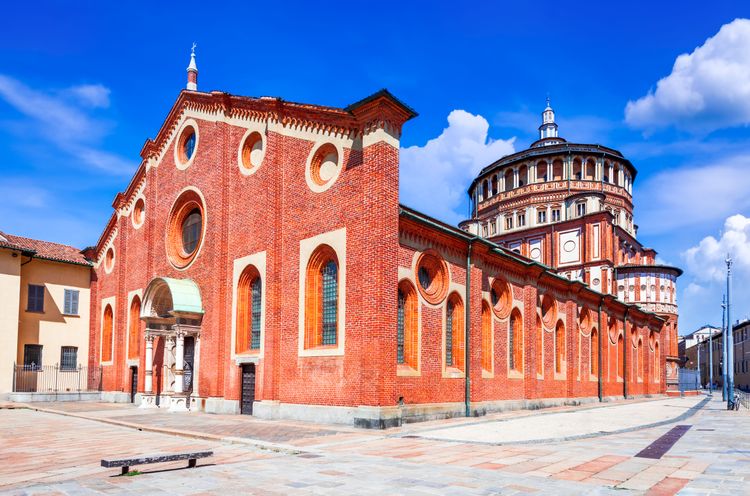
The church of Santa Maria delle Grazie, famous for hosting Leonardo da Vinci's masterpiece "The Last Supper" in Milan, Italy.
- © ecstk22 / ShutterstockThe history of the basilica
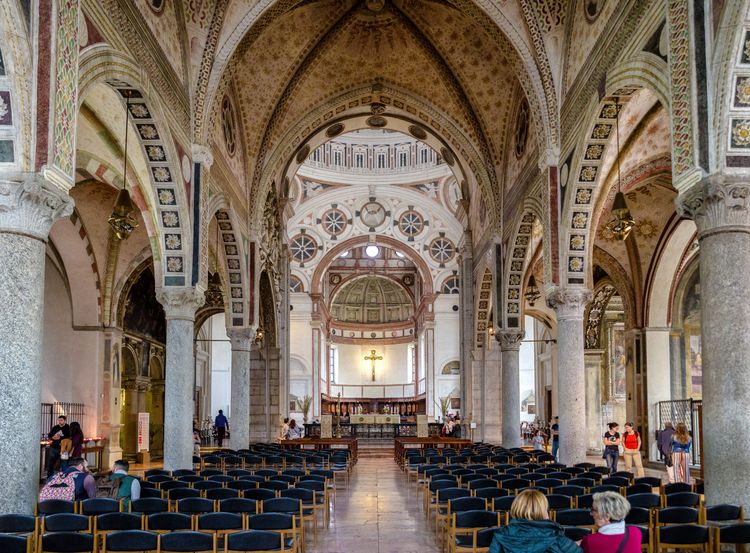
Interior of the Santa Maria delle Grazie church, Milan, Italy.
- © Jaroslav Moravcik / ShutterstockThe construction of the church follows the movement launched in Northern Italy and respects the codes of the region's architectural tradition, with Gothic naves and the use of brick for the facades. It's easy to see why this monument is so important to the people of Milan and so much sought-after by curious tourists. It's an architectural splendour! In 1492, the architect Donato Bramante was commissioned by the youngest son of the Duke of Milan, Ludovico Sforza Le More, to create a new building that would one day house his remains. His wish was never fulfilled, however, as he was unfortunately stripped of his powers and died in prison.

Church of Santa Maria delle Grazie featuring the Last Supper, Milan, Italy.
- © ShustrikS / Shutterstock✈️ Flights to Milan
Just 1h20 from Paris, Milan is easily accessible by plane.Bramante's tribune
Bramante, the second architect to restore the monastery, designed the interior as a "tribune", consisting of a cubic volume crowned by an immense dome. The perfectly executed circular shape of the dome represents perfection. Two remarkably symmetrical apses are sunk into the walls and protrude from the outer side façades. Even if visitors don't come exclusively for the architecture of the building, we have to admit that once they're inside and in front of it, they're left speechless by this large-scale project, which, for its time, was a major challenge. The balance of proportions fascinates and commands respect.
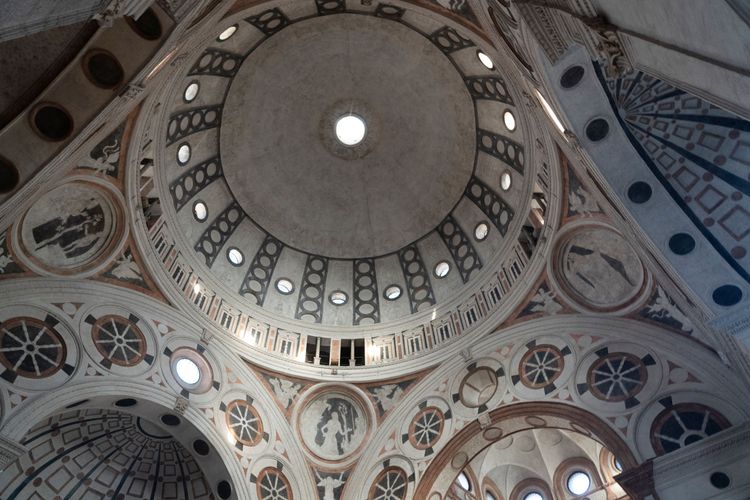
Bramante's tribune overlooked by the dome inside the Santa Maria delle Grazie church, Milan, Lombardy, Italy.
- © Claudio Giovanni Colombo / ShutterstockOutside, the tribune overlooks the nave of the church to the west, Corso Magenta to the south, Via Caradossa to the east and the Cloister of the Frogs to the north. The apses are symmetrical on both sides. At the top of the dome, a small lantern can be seen, placed like a subject on a cake to complete the ensemble. On the north side, a campanile is attached.

Exterior view of the church of Santa Maria delle Grazie, Milan, Lombardy, Italy.
- © Ungvari Attila / ShutterstockThe Last Supper by Leonardo da Vinci
Ludovico Sforza, known by his nickname Il Moro, gave Leonardo da Vinci carte blanche to decorate the refectory. A place where Dominican monks meditated and ate their meals. Little did the Florentine know that the church would become so famous thanks to his work. For the record, he did not receive a single cent for his work, but like all passionate artists, he never claimed his due.

Leonardo da Vinci's Last Supper in the refectory of the former convent of Santa Maria delle Grazie, Milan, Italy.
- © Ungvari Attila / ShutterstockLeonardo da Vinci's Last Supper occupies the northern part of the refectory. The painting technique used by the artist makes the work very fragile and crumbly. The wall was first painted with a preparatory coat to smooth it out. He then applied the pigments over this layer. This choice, combined with environmental hazards, reduced the intensity of the colours and greatly weakened the fresco. Despite numerous restorations and attempts to preserve the painting, this has only worsened its condition, which has deteriorated over the years. Since the 2000s, the painting has been strictly controlled and conditions for visitors have changed. Nowadays, visitors have to book a specific time to view the painting. These new regulations are designed to slow down the excessive deterioration caused by water vapour and condensation. We recommend that you book this attraction in advance of your visit to Milan.
Did you know?
Leonardo da Vinci mixed pigments with egg yolk to obtain a painting. This is a fatty tempera applied to a dry plaster wall. This technique accentuates tones and reflections in the light.
Practical information
How do I book tickets to see the work?
As mentioned above, it's essential to plan your visit to the site, otherwise you run the risk of missing out. Tickets can be booked on the website .
How do I get there?
Tram: line 16 stop Santa Maria delle Grazie
Bus: line 50 stop Piazza Giovine Italia or Cadorna M1 M2
Address:
Piazza di Santa Maria delle Grazie, 20123 Milan
Telephone number:
(0039) 02.467.6111
Opening times :
Monday to Saturday, 9am to 12.20pm and 3pm to 5.50pm
Sundays and public holidays from 3pm to 5.50pm
All about The Last Supper with a local guide
Discover the secrets of the famous painting by Leonardo da Vinci with a guide.Where to eat nearby?
Welcome to Boccondivino, a traditional trattoria where the dishes are served from trolleys. As soon as we step inside, we know that we're in for an unforgettable evening. The restaurant staff welcomed us with arms full of fresh vegetables to dip in homemade olive oil for an aperitif, accompanied by a glass of prosecco. The house motto is to offer the best of Italy. Primi piatti, secondi piatti... not forgetting the highlight: the double cheese farandole. We warn you to save your stomach, as the meals here are very hearty! And the value for money is unquestionably the best in town. This place is a nugget and our favourite in Lombardy (so don't tell anyone).
